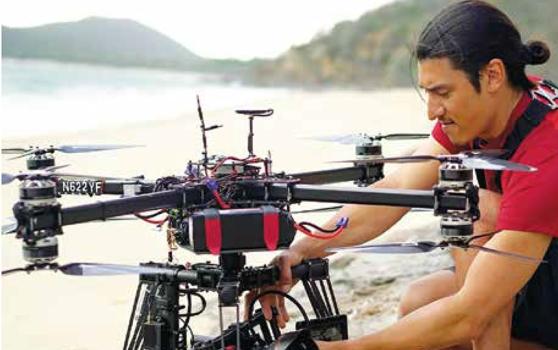“We specialize in existential threats,” filmmaker Jeff Orlowski says of his production company, Exposure Labs. His latest film, “The Social Dilemma,” which explores the unsettling ways social media and online culture are reshaping our society, premiered at the Sundance Film Festival in 2020. Before turning his attention to technology, Orlowski served as the director, producer and cinematographer of “Chasing Ice” and “Chasing Coral,” two award-winning films that document the evidence of climate change in stark relief. “Climate change is one of the biggest threats to humanity at large,” he says. “But as surprising as it may seem, the way our technology is designed to make us more disconnected from truth and reality is also an existential threat to us all.” Orlowski credits his father, a Tottenville HS social studies teacher, with instilling in him a love for both photography and adventure. “It was incredibly magical to be in the darkroom in our house and make images come to life,” he says. As a senior at Stuyvesant HS in Manhattan, Orlowski was editor in chief of the school newspaper on 9/11. Covering the aftermath of that act of terrorism was the first step on his journey tackling important issues on a worldwide scale. “National Geographic was a huge source of inspiration to me as a kid,” he says. “When I was able to visit all seven continents before I turned 30 and show the world what’s at stake with climate change — I was completely living the dream I had in my mind.”
I lived two blocks from an elementary school in Eltingville on Staten Island, but in kindergarten I tested into an advanced program at PS 42, and from there I went on to the advanced program at IS 7. Those programs helped nurture and cultivate me and pushed me in many ways. Now I think back on the privilege that comes with that — that when a kid is fostered well, they can go on to do a lot of powerful things. That’s the kind of care that every student should get.
I wrestled with the decision about whether or not to go to Stuyvesant HS. All my friends were going to local high schools on Staten Island. It meant an hour and a half commute each way, and I wasn’t exactly thrilled by that notion. I recently stumbled across a printed email from Mrs. Block, my 5th-grade teacher at PS 42. She wrote me a really kind note saying that she knew I would make the right decision for me. It meant enough to me that I printed it. I decided that it was a rare opportunity to go to a school that was tough to get into. Every day my parents drove me to catch the 6:21 a.m. train on Staten Island to the ferry to the subway. To go from Staten Island to Manhattan at that age really felt like venturing into the unknown, big world. It really cultivated a lot for me.
At Stuyvesant HS, I felt surrounded by smart people who were challenging me all the time, and that was really special. I was the editor in chief of the newspaper on 9/11, when I was a senior. That was a massively formative experience. We were four blocks away from the World Trade Center, trying to cover it for the school and process it as a community.
Holly Ojalvo was my journalism teacher at Stuyvesant, but it felt more like she was my mentor and my guide. A New York Times editor came in every week and taught us about the ethics of journalism as practiced by The New York Times. That was my formative experience growing up around news coverage, and it gave me so much admiration and respect for journalism. I’m so fortunate to have had that experience; it’s pretty beautiful to look back at.
Fee Soohoo was an art teacher at Stuyvesant who connected me with a youth leadership program called Camp Rising Sun, an atypical summer camp with youth from all around the world. I don’t think she had any sense of how much her recommendation reshaped the path of my life. It was a phenomenal program that opened up the world to me in a different way — to be in the pre-internet, pre-mobile phone era and have friends from 20 to 30 different countries around the world completely changed my life.
Through Camp Rising Sun, I met people working in youth activism. They connected me with Jane Goodall, who became my friend and a lifelong mentor. So there’s a direct line from Ms. Soohoo to Camp Rising Sun to Jane Goodall.
Jane Goodall planted yet another huge seed in my mind as someone who’s been speaking on behalf of nature her entire life. I’ve seen her lecture 50 to 100 times. It made me feel like I had the opportunity and the need to do that in a society that’s forgotten its connection with nature and its dependence on it.
— As told to reporter Rachel Nobel
